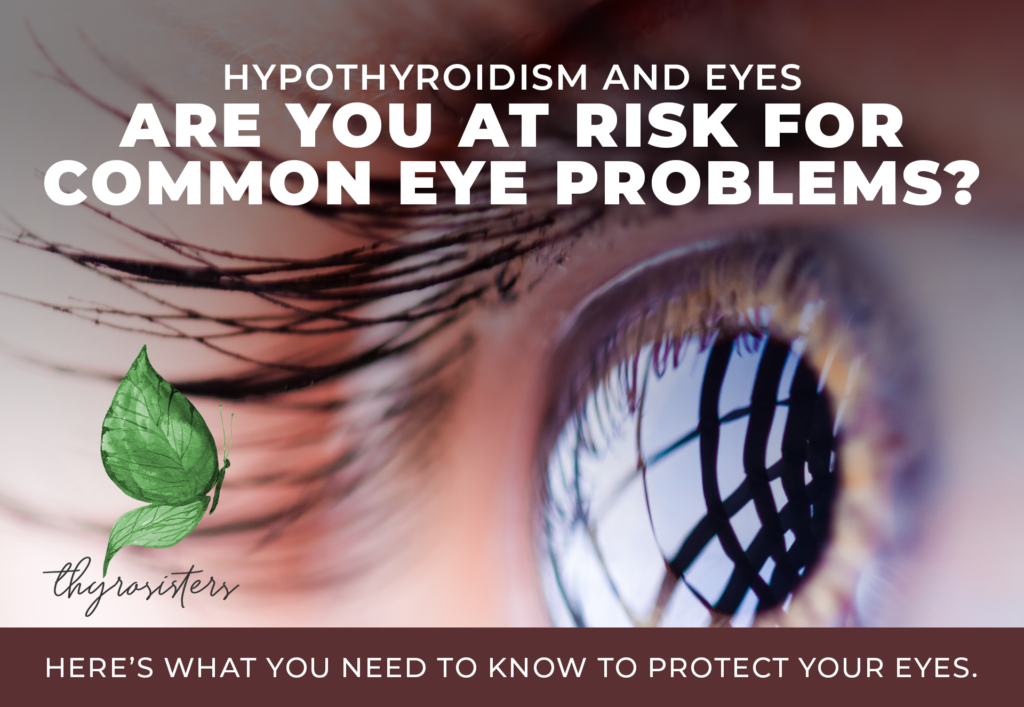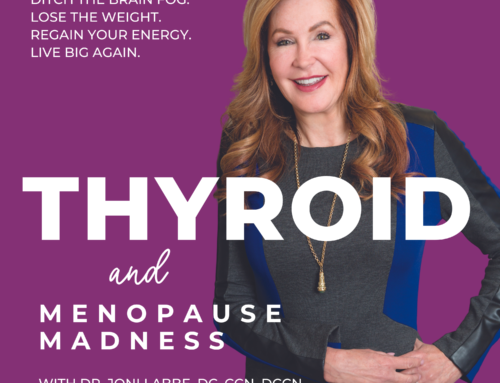ThyroSisters, let’s put the spotlight on your beautiful eyes. Have you been experiencing more eye strain, dry eyes, or other vision problems, especially since COVID? You aren’t the only one. It turns out there is a huge connection between thyroid health and vision. Low thyroid hormone shuts down cellular metabolism in the eyes, much like it does in the rest of the body. That means being hypothyroid can put you at risk for uncomfortably dry eyes as well as a number of eye diseases. When you add hours upon hours of pandemic screen time to this, it can create a perfect storm, harming your beautiful eyes.
Keep reading to find out my favorite sight-saving natural solutions and say goodbye to your thyroid-related eye problems—or stop them from developing in the first place. But before we dig down deep into specific thyroid-related eye concerns, let’s tackle a couple of general eye problems. I’m seeing these problems in more and more of my patients.
Blue Light Effect on Eyes
You probably spend a lot of your day looking at a cell phone, electronic tablet, computer, Kindle, or other electronic devices. Thanks to COVID, countless Zoom meetings, and kids’ online classes, the amount of time spent on these devices skyrocketed in 2020. These types of gadgets spew out what’s known as blue light. Too much blue light is one of your eyes’ worst enemies.
What is blue light? It has to do with the range of wavelengths and energy in visible light. Of all the lights in the visible light spectrum, blue light is the one with the most powerful energy. For this reason, it can push deep into your eyes’ retinas and cause lots of harm. Blue light is linked to macular degeneration, eye strain when you’re looking at a computer or other device, blurry vision, dry eyes, and cataracts. ThyroSisters, you’re already at higher risk for some of these problems anyway. So you’re just adding fuel to the fire when you load up on screen time.
I know, I know. How can you do without your cell phone or iPad? The fact is, in today’s world, you can’t. So, at the end of this post, I’ll offer some ways to counteract blue light damage.
Post-COVID Eye Problems
Since COVID, more and more of my patients are complaining about their eyes going bad. Shockingly, this is happening as early as their 30s! Blame some of this on the increased screen time and exposure to blue light I talked about above. But COVID itself is linked to eye damage, especially if you had a serious case of the COVID crud. Research shows that in people with severe cases of COVID, nodules can form deep in the eyes.1 COVID is also linked to conjunctivitis, an eye condition more commonly called pink eye.2
Hypothyroidism and the Eyes
Low thyroid function can cause you to lose your vision. Two eye diseases are more common in hypothyroidism. The first one is primary open angle glaucoma.3-5 It is the most common cause of irreversible blindness in the world. Since it has no symptoms, it is called the “sneak thief of sight.” It’s caused by damage to the optic nerve of the eye. The other eye disease to watch out for if you have hypothyroidism is age-related macular degeneration (AMD). It is caused by damage to the eye’s macula, which controls sharp vision. AMD doesn’t cause complete blindness but rather causes a loss in central vision. This may make it harder for you to read, drive, see faces, or do close up tasks like cooking your favorite meals.
Hypothyroidism may also boost your risk of non-infectious uveitis, a type of eye inflammation. This can cause your eyes to get red and painful and your vision to become blurry. It can lead to permanent vision loss, so don’t ignore this condition.
So what’s the good news? Now that you have this knowledge, it empowers you to take the steps necessary to keep your eyes healthy as well as your thyroid gland.
Levothyroxine (Synthroid®) Side Effects Include Dry Eyes
Your eyes depend on moisture to stay healthy and comfortable. Tears bathe your eyes constantly, wash away debris, and protect your eyes from infection. When your tears dry out, salt is left behind and it is very irritating to your eyes.
Unfortunately, hypothyroidism and dry eyes often go hand in hand. Sometimes, this is a direct result of the disease itself. Other times, it’s a hypothyroid medication side effect. Synthroid is a common medication used to treat low thyroid function. But dry eyes are a common side effect of the drug.
Hashimoto’s and Dry Eyes
Likewise, dry eyes and Hashimoto’s thyroiditis are a painful pair that often happen together. For example, a study compared people with Hashimoto’s to healthy participants.6 The study found that Hashimoto’s patients were more likely to suffer from dry eyes. Turn the water works back on (the good water works, anyway) by taking some of the eye care botanicals I mention later in this blog post.
Surprising Cases of Thyroid Eye Disease in Hypothyroid Patients
Scientists and doctors have known for a long time now that people with a type of autoimmune hyperthyroidism (overactive thyroid) known as Grave’s disease can suffer from a thyroid eye disease known as thyroid ophthalmopathy or Graves’ ophthalmopathy. But now research shows that some people with hypothyroidism can have this same type of eye problem.
For example, 6% Hashimoto’s patients have it.7 In addition, more than 10% of hypothyroid people also may have thyroid-associated ophthalmopathy.8
When you have this condition, you might have eyes that look like they’re bulging or your eyes may be red and irritated or feel gritty. Your eyes might also feel dry or tear up a lot. And you might be sensitive to light.
Keeping Your Eyesight Sharp and Reducing Dry Eyes
The good news is that keeping your thyroid healthy and balanced is a powerful way to reduce your risks of these eye diseases, not to mention keep your whole body healthier. And I’m excited about the many natural ways to boost eye health and keep your vision on point even when dealing with hypothyroidism and excessive screen time.
Here are some of the most promising natural agents to nourish, protect, and restore your beautiful eyes:
- Lutein and Zeaxanthin from Marigold Flowers – These are yellow-orange carotenoid pigments found in egg yolks, dark green leafy vegetables, and, yes, marigold flowers. They protect the eyes from blue light damage. Plus, they shield your eyes against damage from ultraviolet radiation, too. Research shows lutein and zeaxanthin improve vision, eyestrain, and visual fatigue.
- Maqui Berry – You can thank South America for this deep purple super fruit antioxidant. It can protect cells of the eyes against damage from the sun and blue light.
- Astaxanthin – A carotenoid and powerful antioxidant, it can protect the eyes against damaging free radicals.
- Bilberry – An antioxidant known for its ability to protect the eyes, bilberry can support eye health in people with glaucoma, cataracts, and dry eyes. It boosts blood supply to the retina. In addition, bilberry reduces eye fatigue in people who use the computer a lot.9
- Ginkgo – In people with normal tension glaucoma, ginkgo biloba protected against eye damage and improved blood flow to the eyes.10,11
- Vitamin E Isomers – The shape of vitamin E allows it to slip inside the retinal cells of the eyes, keeping vision sharp and strong. A type of vitamin E known as delta-tocotrienol is especially good at shielding the eyes against free radical damage.
Another nifty eye nutrient? Omega-3 fatty acids, which lubricate dry eyes. Omega-3 fatty acids keep the eyes moist and comfortable. They may work by reducing inflammation, which blocks moisture from forming in the eyes.12 Omega-3s may also stop tears from evaporating.12
Having Problems with Thyroid and Eye Health? Schedule A Clarity Call
Tired of having red, irritated, gritty, or dry eyes? Get in touch with me today for a FREE 30-minute clarity call consultation. I can help support your eye health while addressing deeper concerns such as thyroid balance. You’ll enjoy better vision, more comfortable eyes, and increased energy, libido, and gut health at the same time. And who wouldn’t want that?!
References
- Lecler A, Cotton F, Lersy F, Kremer S, Héran F. Ocular MRI Findings in Patients with Severe COVID-19: A Retrospective Multicenter Observational Study. Radiology. 2021;299(2):E226-e229.
- Willcox MD, Walsh K, Nichols JJ, Morgan PB, Jones LW. The ocular surface, coronaviruses and COVID-19. Clin Exp Optom. 2020;103(4):418-424.
- Wang S, Liu Y, Zheng G. Hypothyroidism as a risk factor for open angle glaucoma: A systematic review and meta-analysis. PLoS One. 2017;12(10):e0186634.
- Cross JM, Girkin CA, Owsley C, McGwin G, Jr. The association between thyroid problems and glaucoma. Br J Ophthalmol. 2008;92(11):1503-1505.
- Bromfield S, Keenan J, Jolly P, McGwin G, Jr. A suggested association between hypothyroidism and age-related macular degeneration. Curr Eye Res. 2012;37(6):549-552.
- Kan E, Kılıçkan E, Ecemiş G, Beyazyildiz E, Çolak R. Presence of Dry Eye in Patients with Hashimoto’s Thyroiditis. J Ophthalmol. 2014;2014:754923.
- Kahaly GJ, Diana T, Glang J, Kanitz M, Pitz S, König J. Thyroid Stimulating Antibodies Are Highly Prevalent in Hashimoto’s Thyroiditis and Associated Orbitopathy. J Clin Endocrinol Metab. 2016;101(5):1998-2004.
- Muñoz-Ortiz J, Sierra-Cote MC, Zapata-Bravo E, et al. Prevalence of hyperthyroidism, hypothyroidism, and euthyroidism in thyroid eye disease: a systematic review of the literature. Syst Rev. 2020;9(1):201.
- Ozawa Y, Kawashima M, Inoue S, et al. Bilberry extract supplementation for preventing eye fatigue in video display terminal workers. J Nutr Health Aging. 2015;19(5):548-554.
- Shim SH, Kim JM, Choi CY, Kim CY, Park KH. Ginkgo biloba extract and bilberry anthocyanins improve visual function in patients with normal tension glaucoma. J Med Food. 2012;15(9):818-823.
- Labkovich M, Jacobs EB, Bhargava S, Pasquale LR, Ritch R. Ginkgo Biloba Extract in Ophthalmic and Systemic Disease, With a Focus on Normal-Tension Glaucoma. Asia Pac J Ophthalmol (Phila). 2020;9(3):215-225.
- Bhargava R, Kumar P, Kumar M, Mehra N, Mishra A. A randomized controlled trial of omega-3 fatty acids in dry eye syndrome. Int J Ophthalmol. 2013;6(6):811-816.






